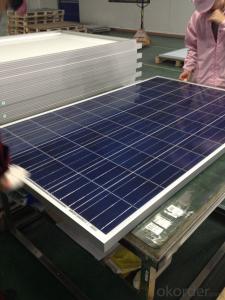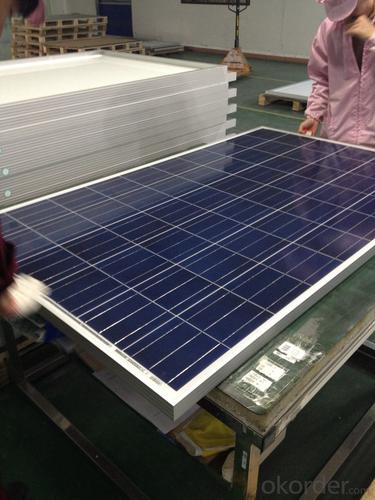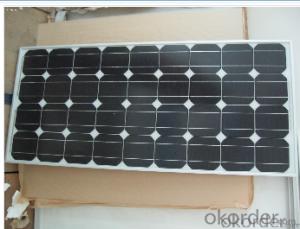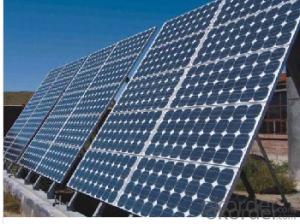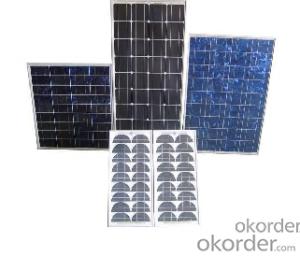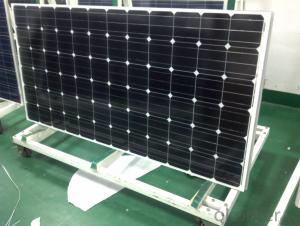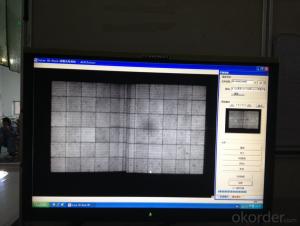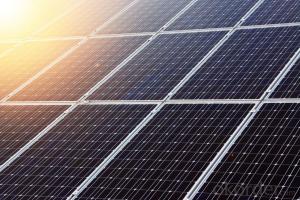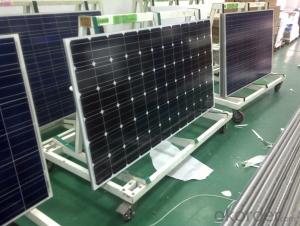Highest Power Polycrystalline Solar Panels-55w for Small Solar Systems
- Loading Port:
- Shanghai
- Payment Terms:
- TT OR LC
- Min Order Qty:
- 10000 watt
- Supply Capability:
- 50000000 watt/month
OKorder Service Pledge
OKorder Financial Service
You Might Also Like
Product Description
Solar Polycrystalline Series Panels
Introduction of Polycrystalline Solar Panels
CNBM Solar photovoltaic (PV) Panel is designed for large electrical power requirements. It is the optimal choice for both on-grid and off-grid power systems. CNBM Solar panel offers high performance of power per square foot of solar array. Polycrystalline silicon(c-Si): often made using the Czochralski process. Single-crystal wafer cells tend to be expensive, and because they are cut from cylindrical ingots, do not completely cover a square solar cell module without a substantial waste of refined silicon. Hence most c-Si panels have uncovered gaps at the four corners of the cells.
Characteristics of Polycrystalline Solar Panels
I Solar Cell : High efficiency crystalline solar cell. Even if under the weak light, the solar module can produce maximum power output.
II Tempered glass (toughened glass): Anti-reflecting coating and high transmission rate glass increase the power output and mechanical strength of solar module.
III EVA and TPT: Using high quality EVA and TPT to prevent destroying and water.
IV AI frame: Without screw, corner connection. 6 holes on the frame can be installed easily.
V Junction box: Multi function junction box with water proof.
VI Long lifetime: ≥25 years; Less power decrease
VII Good performance of preventing from atrocious weather such as wind and hails.
VIII Resisting moisture and etching effectively, not effected by geology.
Standard Test Conditions of Polycrystalline Solar Panels
The opto-electrical specifications shown below are stabilized values being measured at Standard Test Conditions, Irradiance: 1000W/m2, Spectrum: AM1.5 at 25°C, The info below is subject to manufacturing tolerances. Where appropriate minutes of measurement are available and are used for the dimensioning of the installation.
Advantages of Polycrystalline Solar Panels
1.High reliability with guaranteed -3% to +5% power output tolerance, ensuring return on investment
2. High conversion efficiency based on leading innovative photovoltaic technologies
3. Withstands high wind-pressure and snow load, and extreme temperature variations
4. Attractive appearance Unique frame design, high mechanical strength, and easy Installation
Characteristics of Polycrystalline Solar Panels
Max Power Voltage Vmp (V) | 17.4V | 17.6 V |
Max Power Current Imp (A) | 3.17A | 3.41A |
Open Circuit Voltage Voc (V) | 22.4V | 22.6V |
Short Circuit Current Isc (A) | 3.38A | 3.64A |
Max Power Pm (W) | 55W | 60W |
Temperature Coefficient of Cells
NOCT | 47℃±2℃ |
Temperature Coefficients of Isc (%/℃) | 0.06 |
Temperature Coefficients of Voc (%/℃) | -0.33 |
Temperature Coefficients of Pmp (%/℃) | -0.45 |
Mechanical Data Solar Polycrystalline Series
Power | 45W/50W |
Dimension | 820×510×30mm |
Weight | 4.9 kg |
Tolerance | ±3% |
The dimension of the modules can be changed according to the demand of clients Limits.
Operating Temperature | –45 °C to +80°C |
Storage Temperature | –45 °C to +80°C |
Max System Voltage | 700V |
Guarantee Solar Polycrystalline Series Panels
Products Guarantee | 2 years free from defects in materials and workmanship |
Performance Guarantee | No less than 90% within 10yrs and no less than 80% within 25yrs |
Certificates | IEC, ISO, TUV, CE |
Dimension of Solar Polycrystalline Series Panels
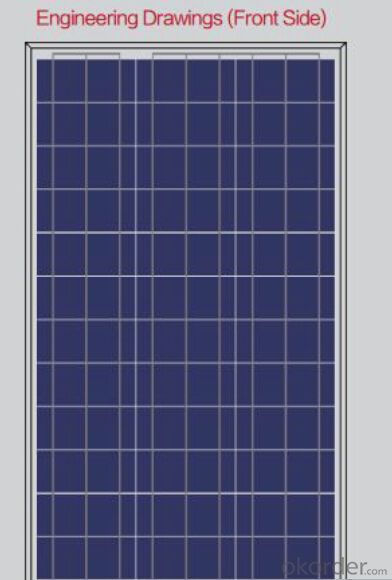
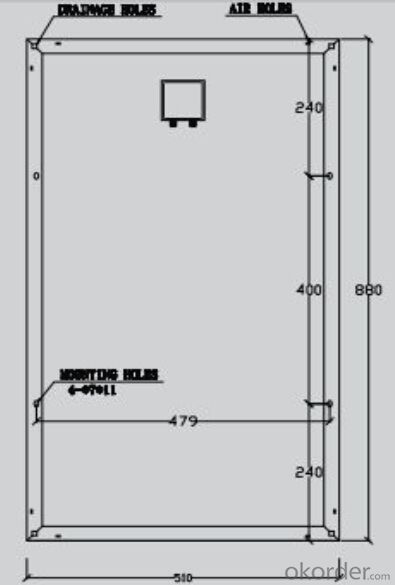
FAQ
We have organized several common questions for our clients,may help you sincerely:
1. What’s price per watt?
A: It’s depends on the quantity, delivery date and payment terms of the order. We can talk further about the detail price issue. Our products is high quality with lower price level.
2. Can you tell me the parameter of your solar panels?
We have different series of cells with different power output, both from c-si to a-si. Please take our specification sheet for your reference.
3. How do you pack your products?
We have rich experience on how to pack the panels to make sure the safety on shipment when it arrives at the destination.
4. What is your warranty system?
Our product performance guarantees for 25 years
• 12 years guarantee for workmanship
• Timeliness of delivery
• Quality Products certified (TÜV, UL, CE, ISO)
5. How do you pack your products?
We have rich experience on how to pack the panels to make sure the safety on shipment when it arrives at the destination.
- Q: How do solar panels affect the property's community engagement?
- Solar panels can have a positive impact on a property's community engagement by promoting sustainable practices and sparking conversations about renewable energy. Solar panels serve as a visible symbol of a property's commitment to reducing carbon emissions and reliance on fossil fuels, which can inspire and encourage others in the community to adopt similar eco-friendly practices. Additionally, solar panels can be used as an educational tool, offering opportunities for community members to learn about solar energy and its benefits, fostering a sense of environmental awareness and collective action.
- Q: Can solar panels be used for powering a concert venue or entertainment center?
- Yes, solar panels can certainly be used to power a concert venue or entertainment center. By harnessing the energy of the sun and converting it into electricity, solar panels can provide a sustainable and renewable source of power to meet the energy demands of such large venues. With advancements in solar technology and the ability to store excess energy, solar panels can effectively contribute to reducing carbon emissions and promoting a greener environment for entertainment spaces.
- Q: I am looking to wire in some solar panels into my home. I already have plenty of wiring, and some solar panels around. I just need to know what I need to do to wire them into my home so I can lower my electric bill. This past month it was six hundred dollars.Can someone direct me to some information, or tell me how without telling me to hire some guy to come out to charge me thirty thousand dollars to install two or three thousand dollars worth of equipment?
- I am all for do-it yourselfers, I am one, but... Sorry to tell you, but connecting solar panels to grid power will require an electrician. There are many requirements for special disconnects to prevent harm to the utillity company workers that must be considered. You will also have to have an inverter sized to match your panels. The simple answer is to connect your panels to something specific, without connecting it into your house wiring. An example is to connect your water well pump to solar power and disconnect it from the grid. But you will still need an inverter and will need to calculate the power demands of the pump and the amount of power available from your panels, which varies by your longitude and latitude. It sound like a simple thing to do, but without special training and experience you will be sorry if you try this yourself.
- Q: What is the lifespan of solar panel batteries?
- The lifespan of solar panel batteries can vary depending on various factors such as the type of battery, its quality, and usage patterns. Generally, solar panel batteries are designed to last between 5 to 15 years. However, with proper maintenance and care, some batteries have been known to last even longer.
- Q: How do solar panels affect the property taxes?
- Solar panels can potentially affect property taxes as they may increase the value of a property. However, the impact on property taxes varies depending on the location and local regulations. In some areas, installing solar panels may qualify homeowners for tax incentives or exemptions, while in others, it may lead to a slight increase in property tax assessments. It is advisable to consult with local authorities or a tax professional to understand the specific implications in a particular area.
- Q: Is it good? ( solar energy)
- Solar power works by capturing photons from the sun and storing their energy in a battery. Solar panels still only capture a very small amount of photons due to technology/distance from the sun/ and probably a number of other reasons. If you wanted to buy a solar panel, you find a company that sells them, send them your electric bill for the past year or so. They calculate the energy restraints, size and additional technical mumbo jumbo. They tell you how much it costs and how much money you could save. Some people might buy a size larger than what they need, in which case they sell the excess energy to your local power company for a few pennies a month(this is usually not very profitable).
- Q: What is the most efficient solar panel, how many would we need to power the United States, and how much land would it take?
- I know that the US uses 500 Gigawatts (giga is 0 ^9). I think a solar panel meter square might generate at most 00W. So you would need 500E9/00 = 5 trillion of these. 5 trillion square meters is 70 kilometers on a side. Dont forget about night and clouds!
- Q: how to market solar energy products?
- You'd better build some sample project. For e.g, if you mean solar water heater, install one pc on your roof, and make it generate hot water, and tell people about it.
- Q: Can solar panels be used for powering agricultural irrigation systems?
- Yes, solar panels can be used to power agricultural irrigation systems. Solar-powered irrigation systems are increasingly being used in agriculture as they provide a sustainable and cost-effective solution. Solar panels convert sunlight into electricity, which can then be used to power pumps and other irrigation equipment, reducing reliance on fossil fuels and electricity grids. This approach helps farmers save on energy costs and reduces their carbon footprint.
Send your message to us
Highest Power Polycrystalline Solar Panels-55w for Small Solar Systems
- Loading Port:
- Shanghai
- Payment Terms:
- TT OR LC
- Min Order Qty:
- 10000 watt
- Supply Capability:
- 50000000 watt/month
OKorder Service Pledge
OKorder Financial Service
Similar products
Hot products
Hot Searches
Related keywords
